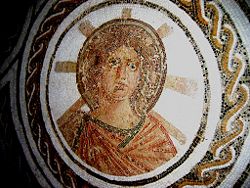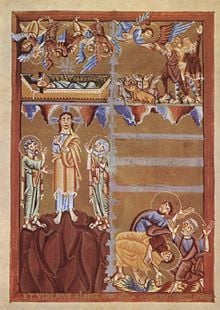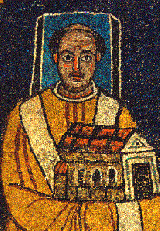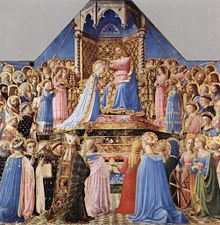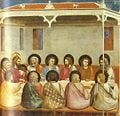Difference between revisions of "Halo" - New World Encyclopedia
Scott Dunbar (talk | contribs) m (→Gallery) |
Scott Dunbar (talk | contribs) m (→In Greek art) |
||
| Line 5: | Line 5: | ||
==In Greek art== | ==In Greek art== | ||
| − | [[Homer]] describes a more-than-natural light around the heads of |heroes in battle,<ref>''[[Iliad]]'' v.4ff, xviii.203ff.</ref> and in [[Aristophanes]]' ''Birds'' the founder of | + | [[Homer]] describes a more-than-natural light around the heads of |heroes in battle,<ref>''[[Iliad]]'' v.4ff, xviii.203ff.</ref> and in [[Aristophanes]]' ''Birds'' the founder of ''Nephelokokkygia'' is extravagantly said to outshine stars and sun.<ref>A hyperbole that would raise a laugh in fifth-century Athens became a poetic commonplace in the panegyrics of the late Roman Empire.</ref> Depictions of [[Perseus]] in the act of slaying Medusa, with lines radiating from his head, appear on a white-ground toiletry box in the Louvre and on a slightly later red-figured vase in the style of Polygnotos, ca. 450-30 B.C.E., in the Metropolitan Museum of Art.<ref>Marjorie J. Milne, "Perseus and Medusa on an Attic Vase" ''The Metropolitan Museum of Art Bulletin'' New Series, '''4'''.5 (January 1946, pp. 126-130) 126.p.)</ref> On painted wares from south [[Italy]] radiant lines or simple haloes appear on a range of mythic figures: Lyssa, a personification of madness; a [[sphinx]], a sea demon, and Thetis, the sea-nymph who was mother to [[Achilles]].<ref>L. Stephani, ''Nimbus und Strahlenkranz in den Werken der Alten Kunst" in ''Mémoires de l'Académie des Sciences de Saint-Petersbourg'', series vi, vol. vol ix, noted in Milne 1946:130.</ref> |
==In Roman art== | ==In Roman art== | ||
Revision as of 08:03, 22 August 2007
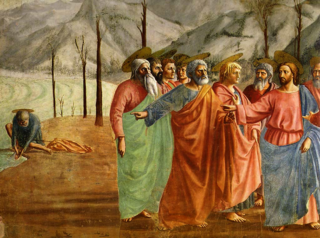
A halo (Greek: ἅλως; also known as a nimbus, glory, or gloriole) is a ring of light that surrounds a person. They are often used in religious works to depict holy or sacred figures. In Hellenistic Greek, Roman, Buddhist and Christian sacred art, sacred persons may be depicted with a halo in the form of a golden, yellow or white circular glow around the head, or a gloriole around the whole body.
In Greek art
Homer describes a more-than-natural light around the heads of |heroes in battle,[1] and in Aristophanes' Birds the founder of Nephelokokkygia is extravagantly said to outshine stars and sun.[2] Depictions of Perseus in the act of slaying Medusa, with lines radiating from his head, appear on a white-ground toiletry box in the Louvre and on a slightly later red-figured vase in the style of Polygnotos, ca. 450-30 B.C.E., in the Metropolitan Museum of Art.[3] On painted wares from south Italy radiant lines or simple haloes appear on a range of mythic figures: Lyssa, a personification of madness; a sphinx, a sea demon, and Thetis, the sea-nymph who was mother to Achilles.[4]
In Roman art
The halo represents an aura or glow of sanctity which was conventionally drawn encircling the head. It first appeared in the culture of Hellenistic Greece and Rome, possibly related to the Zoroastrian hvarena or "divine lustre" imported with Mithraism. Though Roman paintings have largely disappeared, save some fresco decorations, the haloed figure remains fresh in Roman mosaics. In a second century CE Roman floor mosaic preserved at Bardo, Tunisia,[5] a haloed Poseidon appears in his chariot drawn by hippocamps. Significantly, the triton and nereid who accompany the sea-god are not haloed.
In a late second century CE floor mosaic from Thysdrus, (El Djem, (illustration, right) Apollo Helios is identified by his effulgent halo. Another haloed Apollo in mosaic, from Hadrumentum, is in the museum at Sousse.[6] The conventions of this representation, head tilted, lips slightly parted, large-eyed, curling hair cut in locks grazing the neck, were developed in the third century B.C.E. to depict Alexander the Great (Bieber 1964; Yalouris 1980). Some time after this mosaic was executed, the Emperor began to be depicted with a halo, which was not abandoned when they became Christian; initially Christ only had one when shown on a throne as Christ in Majesty.[7]
In Asian art
The halo has been widely used in Indian art, particularly in Buddhist iconography[8] where it has appeared since at least the 2nd century AD. The halo symbol in art may have originated in Central Asia and spread both east and west.[9] In Zen Buddhism, ink brush paintings also commonly use the halo in depictions of saints such as Bodhidharma. In Pure Land Buddhism the halo is used in depicting the image of Amida Buddha. Tibetan Buddhism uses halos extensively in the Thangka paintings of Buddhist saints such as Milarepa and Padmasambhava. Halos also appear in Hindu sculpture and later, in portraits of Mughal and Rajput rulers.[10]
In Christian art
The halo was incorporated into Christian art sometime in the fourth century with the earliest iconic images of Christ, initially the only figure shown with one. Initially the halo was regarded by many as a representation of the Logos of Christ, his divine nature, and therefore in very early (before 500) depictions of Christ before his Baptism by John he tends not to be shown with a halo, it being a matter of debate whether his Logos was innate from birth (the Orthodox view), or acquired at Baptism (the Nestorian view). At this period he is also shown as a child or youth, though this may be a hieratic rather than age-related representation [11]
A cross within, or extending beyond, a halo is used to represent the persons of the Holy Trinity, especially Jesus, and especially in medieval art. In mosaics in Santa Maria Maggiore (432-40) the juvenile Christ has a four-armed cross either on top of his head in the radius of the nimbus, or placed above the radius, but this is unusual. In the same mosaics the accompanying angels have haloes (as, in a continuation of the Imperial tradition, does King Herod), but not Mary and Joseph. Later, triangular halos are sometimes given to God the Father to represent the Trinity in Western art.[12] Square haloes were sometimes used for the living in the first millenium; Pope Gregory the Great had himself depicted with one, according to the ninth-century writer of his vita, John, deacon of Rome.[13]
Occasionally other figures have crossed haloes, such as the seven doves representing the Seven gifts of the Holy Spirit in the 11th century Codex Vyssegradensis Tree of Jesse (where Jesse and Isaiah also have plain haloes, as do the Ancestors of Christ in other miniatures).[14]
Plain round halos are typically used to signify saints, the Virgin Mary, Old Testament prophets, angels, symbols of the Four Evangelists, and some other figures. Byzantine emperors and empresses were often shown with them in compositions including saints or Christ, however the haloes were outlined only. This was copied by Ottonian and later Russian rulers.
Beatified figures, not yet canonised as saints, are sometimes shown in medieval Italian art with linear rays radiating out from the head, but no circular edge of the nimbus defined; later this became a less obtrusive form of halo that could be used for all figures.[15] Mary has, especially from the Baroque period onwards, a special form of halo in a circle of stars, derived from her identification as the Woman of the Apocalypse.
The whole-body image of radiance is sometimes called the 'aureole' or glory; it is shown radiating from all round the body, most often of Christ or Mary. Where gold is used as a background in miniatures, mosaics and panel paintings, the halo is just lines inscribed in the gold, often decorated in patterns within the outer radius, and becomes much less prominent. When gold is not being used, Byzantine haloes are usually just a circular line, sometimes dotted. Christ's halo is often inscribed with text or letters.
Decline of the halo
With increasing realism in painting, the halo came to be a problem for artists. So long as they continued to use the old compositional formulae which had been worked out to accommodate haloes, the problems were manageable, but as Western artists sought more flexibility in composition, this ceased to be the case. In free-standing medieval sculpture, the halo was already shown as a flat disk above or behind the head. When perspective came to be considered essential, painters also changed the halo from an aura surrounding the head, always depicted as though seen full-on, to a flat golden disk or ring that appeared in perspective, floating above the heads of the saints, or vertically behind, sometimes transparent. This can be seen first in Giotto, who still gives Christ the cruciform halo which began to be phased out by his successors.
In in the early 15th century Jan van Eyck and Robert Campin largely abandoned their use, although other Early Netherlandish artists continued to use them. In Italy at around the same time, Pisanello used them if they did not clash with one of the enormous hats he liked to paint. Generally they lasted longer in Italy, although often reduced to a thin gold band depicting the outer edge of the nimbus, usual for example in Giovanni Bellini. Christ began to be shown with a plain halo.
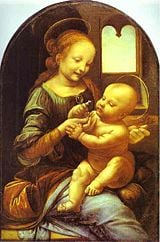
Fra Angelico, himself a monk, was a conservative as far as haloes are concerned, and some of his paintings demonstrate the problems well, as in several of his more crowded compositions, where they are shown as solid gold disks on the same plane as the picture surface, it becomes difficult to prevent them obstructing other figures.
In the High Renaissance, even most Italian painters dispensed with haloes altogether, but in the Mannerist and Baroque periods, figures were placed where natural light sources would highlight their heads, or instead more discreet quasi-naturalistic flickering or glowing light was shown around the head of Christ and other figures (perhaps pioneered by Titian in his late period). Rembrandt's etchings, for example, show a variety of solutions of all of these types, as well as a majority with no halo effect at all.
In popular piety, this practice has led to the literal belief that saints have visible halos around their heads, rather than it be understood as a metaphorical representation. Some faithful believe the halo to be equivalent to the Eastern religion aura, and as with the latter, believe that halos are visible to those with perception. Of the many stories about saints, some reports claimed that a saint was literally glowing.
Spiritual Significance in Christianity
The early Church Fathers expended much rhetorical energy on conceptions of God as a source of light; among other things this was because "in the controversies in the fourth century over the consubstantiality of the Father and the Son, the relation of the ray to the source was the most cogent example of emanation and of distinct forms with a common substance" - key concepts in the theological thought of the time. [16]
In less intellectual interpretations of the haloes of saints, some see the halo as symbolizing the saint's consciousness as 'radiating' beyond the physical body, and that it serves as a pictorial reminder to the saint's devotees of the saint's transcendence of the physical body.
A more Catholic interpretation, less dualistic in its assumptions, is that the halo represents the light of divine grace suffusing the soul, which is perfectly united and in harmony with the physical body.
In a popular Byzantine view, the halo symbolizes a window that the Saints and Christ peer through out of heaven. In this sense, the iconographic figure resides in heaven (symbolized by the gold background) and communicates with the viewer through the window that the halo provides.
Gallery
The Emperor Justinian (and the Empress Theodora) are haloed in mosaics at the Basilica of San Vitale, Ravenna, 548.
In Simon Ushakov's icon of the The Last Supper (1685) eleven of the twelve apostles have halos: only Judas Iscariot does not.
William Blake uses the hats of the two girls to suggest haloes in the frontispiece to Mary Wollstonecraft's "Original Stories from Real Life", 1791.
Notes
- ↑ Iliad v.4ff, xviii.203ff.
- ↑ A hyperbole that would raise a laugh in fifth-century Athens became a poetic commonplace in the panegyrics of the late Roman Empire.
- ↑ Marjorie J. Milne, "Perseus and Medusa on an Attic Vase" The Metropolitan Museum of Art Bulletin New Series, 4.5 (January 1946, pp. 126-130) 126.p.)
- ↑ L. Stephani, Nimbus und Strahlenkranz in den Werken der Alten Kunst" in Mémoires de l'Académie des Sciences de Saint-Petersbourg, series vi, vol. vol ix, noted in Milne 1946:130.
- ↑ Illustrated.
- ↑ Illlustration.
- ↑ Catholic Encyclopedia
- ↑ Metropolitan Museum of Art: Art of South Asia, [1]
- ↑ Metropolitan Museum of Art: Art of South Asia, [2]
- ↑ Metropolitan Museum of Art: Art of South Asia, [3]
- ↑ G Schiller, Iconography of Christian Art, Vol. I,1971 (English trans from German), Lund Humphries, London, p 135, figs 150-53, 346-54. ISBN 853312702
- ↑ [4] Late 15th century reliefs by Jacopo della Quercia on the portal of San Petronio, Bologna are an early example of the triangular halo.
- ↑ Johannes Diaconus gives the reason: circa verticem tabulae similitudinem, quod viventis insigne est, preferens, non coronam ("bearing around his head the likeness of a square, which is the sign for a living person, and not a crown") (Migne, Pat. Lat. 75, 231). The deacon of Rome was unaware of the Eastern tradition of depicting the emperor with a halo. Surviving examples are rare, and seem to be becoming rarer; Bishop Ecclesius has a clear one in older photos of the mosaics in an Vitale, Ravenna, which appears to have been removed in recent restoration [5] - see: James Hall, A History of Ideas and Images in Italian Art, p100 & photo p.93, 1983, John Murray, London, ISBN 0719539714. Other surviving examples are Pope Hadrian I in a mural formerly in Santa Prassede, Rome, donor figures in the church at St. Catherine's Sinai ref and two more Roman examples - items 3 and 5 here, one of Paschal's mother, the rather mysterious Episcopa Theodora.
- ↑ G Schiller, Iconography of Christian Art, Vol. I,1971 (English trans from German), Lund Humphries, London, figs 20-22, ISBN 853312702
- ↑ The distinction is observed in the Christ Glorified in the Court of Heaven (1423-4) by Fra Angelico, National Gallery, London, where only the beatified saints at the edges have radiating linear haloes.
- ↑ Notes on Castelseprio (1957) in Meyer Schapiro, Selected Papers, volume 3, p117, Late Antique, Early Christian and Mediaeval Art, 1980, Chatto & Windus, London, ISBN 0701125144
ReferencesISBN links support NWE through referral fees
- Cormack, Robin. Byzantine Art (Oxford History of Art). Oxford University Press, 2000. ISBN 978-0192842114
- Fisher, Sally. The Square Halo and Other Mysteries of Western Art: Images and the Stories That Inspired Them. Harry N. Abrams, Inc. Publishers, 1995. ISBN 978-0810944633
- McManners, John. The Oxford Illustrated History of Christianity (Oxford Illustrated Histories. Oxford University Press, USA; New Ed edition, 2001. ISBN 978-0192854391
- Morson, Caroline and Maurice Dilasser (Ed.), The Symbols of the Church. Liturgical Press, 1999. ISBN 978-0814625385
- Schiller, G. Iconography of Christian Art, Vol. I. Lund Humphries, London, 1971. (English trans from German).
- Sill, Gertrude Grace. A Handbook of Symbols in Christian Art. Touchstone, 1996. ISBN 978-0684826837
Credits
New World Encyclopedia writers and editors rewrote and completed the Wikipedia article in accordance with New World Encyclopedia standards. This article abides by terms of the Creative Commons CC-by-sa 3.0 License (CC-by-sa), which may be used and disseminated with proper attribution. Credit is due under the terms of this license that can reference both the New World Encyclopedia contributors and the selfless volunteer contributors of the Wikimedia Foundation. To cite this article click here for a list of acceptable citing formats.The history of earlier contributions by wikipedians is accessible to researchers here:
The history of this article since it was imported to New World Encyclopedia:
Note: Some restrictions may apply to use of individual images which are separately licensed.
